Robust dual-channel correlation algorithm for complex weak target detection with wideband radar
DAI Yan ,LIU Dan,* ,LI Chuanming ,WEI Shaopeng ,and HU Qingrong
1.Beijing Institute of Radio Measurement,Beijing 100854,China;2.College of Oceanography and Space Informatics,China University of Petroleum (East China),Qingdao 257099,China;3.Defense Technology Academy of China Aerospace Science and Industry Corporation Limited,Beijing 100070,China
Abstract: In the scene of wideband radar,due to the spread of target scattering points,the attitude and angle of view of the target constantly change in the process of moving.It is difficult to predict,and the actual echo of multiple scattered points is not fully matched with the transmitted signal.Therefore,it is challenging for the traditional matching filter method to achieve a complete matching effect in wideband echo detection.In addition,the energy dispersion of complex target echoes is still a problem in radar target detection under broadband conditions.Therefore,this paper proposes a wideband target detection method based on dual-channel correlation processing of rangeextended targets.This method fully uses the spatial distribution characteristics of target scattering points of echo signal and the matching characteristics of the dual-channel point extension function itself.The radial accumulation of wideband target echo signal in the complex domain is realized through the adaptive correlation processing of a dual-channel echo signal.The accumulation effect of high matching degree is achieved to improve the detection probability and the performance of wideband detection.Finally,electromagnetic simulation experiments and measured data verify that the proposed method has the advantages of high signal to noise ratio (SNR) gain and high detection probability under low SNR conditions.
Keywords: wideband radar,target detection,dual-channel,correlation.
1.Introduction
As the core detector of the space surveillance system,radar plays an irreplaceable role in the early warning detection,tracking,and identification of space defense.However,the traditional wideband and narrowband alternating detection mode,especially for the space maneuvering target detection,makes the data rate low.In addition,the target lock-out problem often occurs in detection and tracking.Therefore,it is critical to change the detection mode of traditional narrowband detection and wideband imaging to pure wideband tracking and imaging mode to improve the detection and measurement data rate of current space maneuvering target detection.However,wideband radar detection has the following problems: (i) wideband waveform resolution is high [1-3],(ii) the target has the phenomenon of distance extension,(iii) the average signal to noise ratio (SNR) is lower than narrowband radar,(iv) and distributed radar scattering energy is difficult to accumulate and utilize effectively,making wideband detection more difficult in practical applications.
In order to solve the above problems,many scholars have studied the target detection of wideband radar.The relevant research results can be roughly divided into coherent accumulation detection and non-coherent accumulation detection.The primary detection methods of wideband radar targets based on coherent accumulation are as follows.Some scholars proposed Bayesian probability detection methods [4,5].Gerlach et al.designed an energy accumulation detection method based on spatial density weighting of scattered points.When the target scattering points are sparsely distributed,the detection performance can be significantly improved [6].In addition,Gerlach et al.derived a modified generalized likelihood ratio test (MGLRT) for the adaptive detection of a target or targets that are distributed in the range [7].Conte et al.proposed an adaptive detection method for range-extended targets in a partially uniform clutter environment in 2001 [8] and compared the two-step generalized likelihood detection operator using the auxiliary unit with the direct one-step generalized likelihood detection operator.In addition,Conte et al.also did a series of research work on generalized likelihood ratio detection[9-11].Bandiera et al.designed and analyzed the generalized likelihood ratio detector for range-Doppler spread targets in a nonhomogeneous clutter environment [12].Some scholars proposed using multiple coherent echoes for target detection [13,14] and an accumulation detector for a single-range image [15,16].The deficiency of the above coherent accumulation detector lies in its significant dependence on prior information.When the preliminary information estimation is inaccurate,it will be mismatched with the natural environment,the detection performance will decline,and the algorithm complexity will be high.
Non-coherent accumulation is representative of the energy accumulation detector proposed by Hughes,which carries out non-coherent accumulation of echo capability in all range units in the detection window [17].Classical detection methods include double-threshold (M/N) detection [18],binary accumulation detector based on spatial density of scattering points and range-spread target detector based on sequence statistics [19,20],and others[21,22].Some scholars also proposed a wideband detection method based on sliding window and a wideband target detection method based on fractal features [23].The problem of this kind of detector is that although it relies less on prior information,it still needs to match with the target feature.When the feature matching is too low,the detection probability will still be low.
In addition to the energy accumulation method,many scholars improved the performance of target detection based on the idea of matching filters.As early as the 1950s,scholars proposed the matched filtering theory in the sense of maximum SNR [24].In the 1970s,scholars used radiometer technology for signal detection,which did not require too much prior knowledge and could adapt to most unknown signal forms,and was widely used [25,26].However,the detection performance of this method could be better under the condition of low SNR.The matching filter is the optimal detector in the white noise background,but the signal form must be known entirely.In practice,because the attitude and perspective of the target echo model are different and unpredictable,it is challenging to meet the complete matching filtering condition.Since correlation detection is mathematically equivalent to matching filtering [27] and has good detection performance for various signals,many scholars have researched it,and correlation detection theory has been widely applied in various disciplines.
In view of the problem of detecting wideband echo signals with low SNR,a detection algorithm of dual-channel correlation accumulation for wideband radar targets is proposed in this paper.By entirely using the scattering distribution and channel characteristics of the echo signal,the correlation processing of the dual-channel signal is carried out to achieve energy accumulation.Then,a detector is designed to improve the robustness of target detection with wideband radar under the condition of low SNR.Through the correlation operation of signals received by two channels,signals can be effectively accumulated in the case of unknown signal form to improve the SNR of echo signals.In addition,the proposed method also makes full use of the weak noise correlation of different channels.In this paper,the correlation performance of wideband echo signals is analyzed theoretically and modeled mathematically,simulation experiments and measured data analysis verify the effectiveness of the proposed method.
The innovation points of this paper are summarized as follows:
(i) Radial accumulation in the complex domain of echo signals is carried out by using the scattering distribution characteristics of echo signals.
(ii) In the actual situation,because the attitude and perspective of the target echo model are different and unpredictable,its complete matching filtering conditions are challenging to meet.Furthermore,the broadband echo energy is dispersed,so the detection probability is low.Therefore,the dual-channel correlation processing in the airspace is used to realize the accumulation of echo energy,and improve the detection probability and the broadband detection performance.
The rest of this paper is structured as follows.Section 2 analyzes the mathematical model of the echo signal.Section 3 designs the wideband radar dual-channel target detector.Simulation experiments and measured data analysis are presented to verify the effectiveness of the proposed target detection method in Section 4.Finally,Section 5 concludes this paper.
2.Mathematical model
2.1 Target echo signal
The following takes two antennas as an example to analyze the echo signals of two channels.Assuming that there are distant targets in θ direction,the waves reflected by the targets arriving at the receiving point are approximately plane waves [28].The distance between the two antennas isd,and the signals received by them generate phase difference φ due to the wave path difference ΔR.The schematic diagram of the signals received by the two channels is shown in Fig.1.

Fig.1 Schematic diagram of signals received by two channels
Assume that the target containsIscattering centers,signal bandwidth isB,and the speed of light is c,then the range resolution is,then the echo signal received by the radar is
whereTpis the pulse width,aiis the amplitude of theith scattering point,f0is the carrier frequency,k=is the frequency modulation slope,fast timet,and slow timeta,τ(i,ta) is the echo delay between theith scattering point and the radar.
The output signal of the chirp signal after matched filtering is
2.2 Signal model and probability model
Assume thats(t) is the target signal and obeys the Gaussian distribution with the mean of 0 and the variance of.n1(t) andn2(t) are the noise received by the two channels and both obey the Gaussian distribution with the mean of 0 and the variance of(independent and identical distribution).τ0is the difference between the target signal delay of the two channels.Assume thats(t),n1(t),andn2(t) are uncorrelated stationary random processes,S1(t) andS2(t) are the received signals of the two channels respectively,the echo signal is
Suppose the receiver bandwidth of both channels isB,sampling frequency isfs=B,and sampling time length isT.After digitization,the received signal can be expressed as
whereNis the number of sampling points,and it is assumed thats(t),n1(t),andn2(t) are complex signals.
The core idea of dual-channel correlation detection is to make use of the scattering distribution characteristics and amplitude-phase information of echo signal and use autocorrelation to accumulate energy for realizing the stacking of correlation peaks of dual-channel echoes.At the same time,due to the independent distribution of noise without correlation,the correlation peak amplitude of the echo signal is accumulated and higher than that of noise,thus improving the detection probability of the target.The correlation function of a dual-channel echo signal is
where (·)∗stands for complex conjugation.
The digital representation of the correlation results of echo signals is as follows:
In the following,the statistical performance of the echo signal is analyzed to prove that the dual-channel correlation processing improves the SNR.
According to the derivation of [29],the mean value of correlation results of echo signals can be expressed as follows.
(i) Wheni=,the result of the correlation between the received signals of the two channels is correlated peak,which can be expressed as
(ii) Wheni≠,the result of the correlation between the received signals of the two channels is base noise,which can be expressed as
The variance of correlation results of echo signals is
According to the analysis calculation,it can be obtained that
The output SNR after correlation is
where SNRirepresents the input SNR,and SNRcrepresents the output SNR after correlation processing.
The output SNR of the correlation processing results SNRcis related to the input SNR,correlation durationNand signal time difference length τ0.
When the number of sampling points is large,N-≈N,then (11) can be simplified as
then the SNR gain is
2.3 Likelihood ratio detection model of echo signal
When there are only echo signal and noise in the echo signal,the detection model is assumed to be
whereSt(t) represents the signal,andn(t) represents the noise.Under the assumption of H0,there is only noise in the echo;under the assumption of H1,there is a signal in the echo,and the echo signal is the superposition of signal and noise.
The likelihood ratio can be directly obtained from (15)and (16) as follows:
Fig.2 shows the flow chart of echo signal likelihood ratio detection.

Fig.2 Flowchart of echo signal likelihood ratio detection
3.Wideband radar dual-channel target detector
In wideband radar,it is assumed that the transmitting signal is linear frequency modulation (LFM) signal.Because of the high range resolution of the LFM signal in the wideband case,the target may occupy more than one range unit.Assume that the echo signal received by Channel 1 iss1(t);the echo signal received by Channel 2 iss2(t);then the echo signal after the correlation between the two channels [30] is
where ⊗ is the correlation operation,Tpis the pulse width,aiis the amplitude of theith scattering point,f0is the carrier frequency,k=is the frequency modulation slope,τiis the echo delay between the scattering point and the radar.n(t) is the Gaussian white noise,whose mean is 0 and variance is σ2,andnC(t) is the noise term after correlation operation.Since the signal acquisition and processing process of each channel is completed independently,this paper assumes that the noise of different channels is independent.
CSS(t) is the signal item wheni=p:
CSI(t) is the interference item wheni≠p:
Fig.3 shows the echo signal diagram of Shenzhou spacecraft electromagnetic simulation model after doublechannel correlation.As shown in Fig.3,the energy of the received echo signal is relatively concentrated for this target after the correlation operation,the more concentrated the signal energy,the more conducive to detection.Therefore,the algorithm proposed in this paper can achieve better performance under the condition of low SNR.

Fig.3 Echo signal diagram of Shenzhou spacecraft electromagnetic simulation model after double-channel correlation
Compared with narrowband radar,wideband radar has higher range resolution,so for complex space target detection,space target echo signal takes up more range units.Therefore,assuming that the space target echo signal occupies five distance units,according to (12),the relationship between SNR after correlation (SNR1) and SNR of echo signal (SNRe) is
Fig.4 shows the relationship between the SNR after correlation (SNR1) and the echo signal’s SNR (SNRe).

Fig.4 Relationship between the SNR after correlation (SNR1)and?the echo signal’s SNR (SNRe)
As seen from Fig.4,the SNR after cross-correlation has a gain relative to the SNR of the echo signal.When the SNR of the echo signal is 0.233 5 dB,the SNR after cross-correlation is 2.528 0 dB,and the gain of SNR is 2.294 5 dB.The SNR gain after cross-correlation increases with the increase of echo signal.
More scattering centers exist in the echo signal for complex space targets,and the SNR gain after cross-correlation processing is more extensive,which can realize the effective accumulation of cross-correlation processing energy.
Compared with narrowband radar,wideband radar has a higher range resolution,so the echo signal has more scattering points.Using the accumulation method of the correlation function of two channels,the energy of multiple scattering units can be effectively accumulated and utilized to realize the effective accumulation of correlation processing.
In an actual situation,it is unknown whether there is a target;when there is a target,the target’s location information is also unknown.Therefore,the high resolution range profiles (HRRPs) of the two channels are processed with sliding window correlation.The window length is set asNaccording to the prior knowledge of the target size.The sliding window length is set asM(M The determination method of threshold coefficientKis as follows: the noise in the echo signal is processed by sliding window correlation alone,the value range of threshold coefficientKis set as [3:0.01:4],and 2×107Monte Carlo simulation experiments are conducted to detect the false alarm probability of echoes processed by sliding window correlation with noise.Fig.6 shows the relationship between false alarm probability and threshold coefficientK. Fig.6 Graph of relation between false alarm probability and threshold coefficient K As can be seen from Fig.6,whenK=3.58,the probability ofa false alarm is 1.026×10-4,and whenK=3.59,the probability of a false alarm is0.982 4×10-4.Therefore,the experiment in this paper takesK=3.59. The detection threshold is the constant false alarm adaptive detection threshold,the set protection unit is 50,and the values of about 1 000 cells are taken as the noise statistics. Taking Shenzhou spacecraft as the electromagnetic simulation model,the distance from radar is set asR,the distance of linear array is set asd,the rotation angle of the model is set as θ,Cis the initial position of the model,andDis the position after rotation of the model.Fig.7 is the model diagram of electromagnetic simulation,and Fig.8 is the location diagram of the model. Fig.7 Model diagram of electromagnetic simulation Fig.8 Location diagram of the model Then the wave path difference from the target to the center of the linear array is the corresponding initial difference is Assume that the echo signal received by linear arrayAis the signal received by Channel 1,and the echo signal received by linear arrayBis the signal received by Channel 2. The simulation parameters are shown in Table 1. Table 1 Simulation parameters Fig.9 shows the echo signal diagram of the two channels under ideal conditions. Fig.9 Two channel echo signal diagrams under ideal conditions By comparing Fig.9(a) and Fig.9(b),it can be seen that the echo signals of the two channels are similar.Gaussian white noise is added to the echo signal so that the SNR of the echo signal is 12 dB.Fig.10 is the echo signal diagram of two channels under the condition of 12 dB SNR,and Fig.11 shows the test statistic of sliding window correlation of two channel echo signal. Fig.10 Echo signal diagram of two channels under 12 dB SNR Fig.11 Test statistic of sliding window correlation of two channel echo signal Since the target’s location is known,the distance units of the two channels are taken for correlation processing to calculate the SNR gain of correlation processing.Fig.12 shows the echo signal diagram of the two-channel echo signals [4 900,5 100] after correlation processing. Fig.12 Echo signal diagram of two channels after correlation processing After correlation processing,the maximum amplitude of the echo signal in Fig.12 is 5.63×109,and the SNR can be calculated to be 16.4 dB,so the SNR gain of the echo signal after correlation processing is 4.4 dB.In practice,due to the fluctuation of echo and noise,the SNR gain of the echo signal after correlation processing also fluctuates. The signal’s peak power is used to calculate the SNR in the experiment.The formula can be expressed as whereSrepresents the echo signal,andPnrepresents the noise power. Table 2 shows the SNR of the dual-channel echo signals after correlation processing in the case of 12 dB SNR. Table 2 SNR of the dual-channel echo signals after correlation processing in the case of 12 dB SNR dB According to the data in Table 2,the average value of the eight SNRs is 16.7 dB,and the average value of the SNR gain is 4.7 dB. Repeat the above experimental steps.After 10 000 Monte Carlo experiments,the SNR after correlation processing of echo signals with SNR ranging from 8 dB to 15 dB is obtained respectively,and the average value of 10 000 times of data is taken.The results are shown in Fig.13 and Table 3. Table 3 SNR of channel 1 echo signal SNR1 and SNR after correlation processing SNRc dB Fig.13 Diagram of the SNR of channel 1 echo signal SNR1 and SNR after correlation processing SNRc It can be seen from Table 3 and Fig.13 that the echo signals are effectively accumulated,and the SNR is improved after correlation processing.When the SNR is low,the echo signal is greatly affected by noise correlation,and the SNR gain is negligible.With the increase of the SNR,the impact of noise correlation on echo signal becomes less and less,and the SNR gain becomes larger and larger. In order to verify the improved detection performance of the proposed dual-channel correlation detector compared with the traditional detector,simulation experiments are carried out.Traditional algorithms for comparison in this paper are as follows: two-threshold MN detection,radial integral (RI) detection,and order statistic (OS) detection. The experimental parameters are set as follows: MN detector window length is 8,the reference unit is 20,the protection unit is 10,Mis 3,andNis 8.Next,the OS detector window length is set to 8,the reference unit is 20,the protection unit is 10,and the enormous energy number is set to 6.Finally,the RI detector window length is set to 7,the reference unit is 20,and the protection unit is 10. The SNR of echo signal is from 0 dB to 30 dB and the echo signal after its correlation processing are detected with a constant false alarm,and all detectors’ constant false alarm rateis setto10-4. After 10 000 Monte Carlo experiments,the detection probability of each detector changing with the SNR curve is obtained,as shown in Fig.14.Dual-channel correlation (Dcc) in Fig.14 represents the detection result of the dual-channel correlation detector. Fig.14 Curve of detection probability of different detectors as a function of SNR As shown in Fig.14,after correlation processing,the detection probability of the echo signal is improved.For example,when the SNR is 10 dB,the detection probability of the proposed method is 0.985,the detection probability of the MN detector is 0.04,and the detection probability of both the OS and RI detectors is 0.Under the condition of the same SNR,the detection performance of the detector proposed in this paper is better than those of the three traditional detectors.Because the scattering point of the target expands,and the attitude and angle of view of the target constantly change and are difficult to predict in the process of moving,the actual echo is a complex superposition of the echo of multiple scattering points,which does not fully match the transmitted signal.The adaptive correlation processing of a dual-channel echo signal takes advantage of the spatial distribution characteristics of the target scattering points for the echo signal and the matching characteristics of the two-channel point extension function itself,which is equivalent to realizing the matching filtering processing with a high degree of matching,to accumulate the dispersed broadband echo energy,improve the detection probability and the wideband detection performance. 4.4.1 Measured data of space target 1 The measured data of space target 1,and the multi-period echo diagram of the sum channel and the compensated difference channel are shown in Fig.15. Fig.15 Two channel echo signal diagrams of space target 1 Take the data of echo period 2 000,and the echo diagram is shown in Fig.16. Fig.16 Echo signal diagram of the 2 000th cycle According to Fig.16(a),the maximum amplitude of the echo signal of the “and” channel is about 4.513×105,and the noise power of the [200,400] distance unit is 101.5 dB as the noise power of the echo signal,so the SNR of the echo signal is 11.6 dB.According to the target size,take the window length as 100.Fig.17 shows the test statistic of sliding window correlation of the 2 000th cycle echo. Fig.17 Test statistic of sliding window correlation of the 2 000th cycle echo Fig.18 shows the echo diagram of the data of echo period 2 200. Fig.18 Echo signal diagram of the 2 200th cycle According to Fig.18(a),the maximum amplitude of the echo signal of the “and” channel is about 5.048×105,and the noise power of the [200,300] distance unit is 98.5 dB as the noise power of the echo signal,so the SNR of the echo signal is 15.6 dB.Fig.19 shows the test statistic of sliding window correlation of the 2 200th cycle echo. Fig.19 Test statistic of sliding window correlation of the 2 200th cycle echo The 2 000th cycle and channel echo signals are detected by the dual channel detector and the three traditional detectors,respectively.The experimental parameters of the three traditional detectors are set as follows:MN detector window length is 8,the reference unit is 20,the protection unit is 10,Mis 3,andNis 8.Next,the OS detector window length is set to 8,the reference unit is 20,the protection unit is 10,and the enormous energy number is set to 6.Finally,the RI detector window length is set to 7,the reference unit is 20,and the protection unit is 10.The constant false alarm rate of all detectors is set to 10-4. Fig.20 shows the inspection statistics and threshold values of four detectors after processing echo signals,in which the Dcc detector represents the double-channel sliding window correlation detector. Fig.20 Graph of detection results of four detectors on space target 1 As shown in Fig.20,the threshold values of the RI,OS,and MN detectors are all higher than the test statistics,so no target signal is detected.However,after this paper’s correlation processing of the echo signal,its test statistics are higher than the threshold values,and the target signal can be detected. 4.4.2 Measured data of space target 2 The measured data of space target 2,and the multiperiod echo diagram of the sum channel and the compensated difference channel are shown in Fig.21.Take the data of echo period 2 200,and the echo diagram is shown in Fig.22.According to Fig.22(a),the maximum amplitude of the echo signal of the “and” channel is about 8.494×105,and the noise power of the [300,400] distance unit is 109.7 dB as the noise power of the echo signal,so the SNR of the echo signal is 8.9 dB.According to the target size,take the window length as 100. Fig.21 Two channel echo signal diagrams of space target 2 Fig.22 Echo signal diagram of the 2 200th cycle Fig.23 shows the test statistic of sliding window correlation of the 2 200th cycle echo. Fig.23 Test statistic of sliding window correlation of the 2 200th cycle echo Fig.24 shows the echo diagram of the data of echo period 2 400. Fig.24 Echo signal diagram of the 2 400th cycle According to Fig.24(a),the maximum amplitude of the echo signal of the “and” channel is about 1.44×106,and the noise power of the [300,400] distance unit is 100.7 dB as the noise power of the echo signal,so the SNR of the echo signal is 22.5 dB.According to the target size,take the window length as 100.Fig.25 shows the test statistic of sliding window correlation of the 2 400th cycle echo. Fig.25 Test statistic of sliding window correlation of the 2 400th cycle echo The measured data show that the wideband radar target dual-channel correlation detection algorithm has the effect of energy accumulation on the echo signal to generate SNR gain.Moreover,the accumulation effect is related to the number of scattering points of the target,generally,the more scattering points of the target,the more energy accumulation. The 2 400th cycle and channel echo signals are detected by the dual channel detector and the three traditional detectors,respectively.The experimental parameters of the three traditional detectors are set as follows:the MN detector window length is 8,the reference unit is 20,the protection unit is 10,Mis 3,andNis 8.Next,the OS detector window length is set to 8,the reference unit is 20,the protection unit is 10,and the enormous energy number is set to 6.Finally,the RI detector window length is set to 7,the reference unit is 20,and the protection unit is 10.All detectors’ constant false alarm rate is set to 10-4. Fig.26 shows the inspection statistics and threshold values of four detectors after processing echo signals,in which the Dcc detector represents the double-channel sliding window correlation detector. Fig.26 Graph of detection results of four detectors on space target 2 As can be seen from Fig.26,the threshold values of the OS detector and MN detector are both higher than the test statistics,so no target signal is detected.The test statistics of the RI detector and the correlation detector in this paper are higher than the threshold values,so the target signal can be detected. Gaussian white noise is added to the periodic signal to make the SNR range of echo signal from 5 dB to 22 dB.Monte Carlo simulation experiments are done 10 000 times for the four detectors,and the detection probability changes with the SNR curve are quantified to obtain the statistical performance of the measured data.Additional SNR (ASNR) is defined as where SNRmaxis the amplitude SNR of the measured signal,whose value is 22.5 dB,PNis the added noise power,then the experimental ASNR is set as 5-22 dB.Table 4 shows the detection probabilities of the four detectors under different SNRs,in which the Dcc detector represents the dual-channel correlation detector. Table 4 Detection probability of four detectors under different SNRs (partial SNR) It can be seen from Table 4 that,within the range of 5-22 dB SNR,the detection probability of the three traditional detectors is 0,while that of the dual-channel sliding window correlation detector is 1. In the actual situation,because the attitude and angle of the target echo model are different and unpredictable,the complete matched filtering condition is challenging to meet,and the detection probability of wideband echo energy dispersion could be higher.In order to solve the problem,a wideband radar target signal detection algorithm based on dual-channel correlation is proposed.The energy of multiple scattering units can be accumulated effectively using the accumulation of the correlation function of two channels. The simulation results of the Shenzhou spacecraft model show that this algorithm can effectively improve the SNR of the echo signal.For example,when the SNR of the echo signal is 12 dB,this algorithm’s mean SNR gain is 4.7 dB.In addition,by comparing with the twothreshold,radial integral,and order statistic detector,it is verified that the detector proposed in this paper has good detection performance compared with the traditional detectors.Moreover,the effectiveness of the proposed method and its engineering application value is further verified through the analysis of measured data.The proposed method is superior to three traditional detectors for low SNR detection of complex targets.
4.Experiments and discussions
4.1 Model of simulation experiments

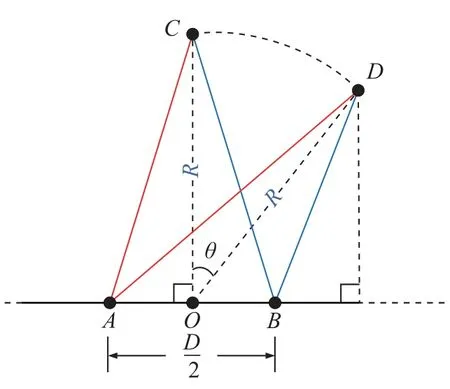
4.2 Experiment I: validation of the detection method
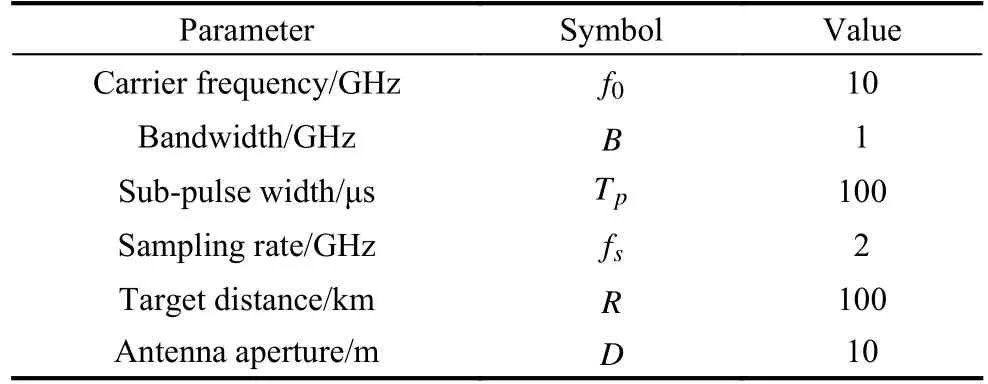





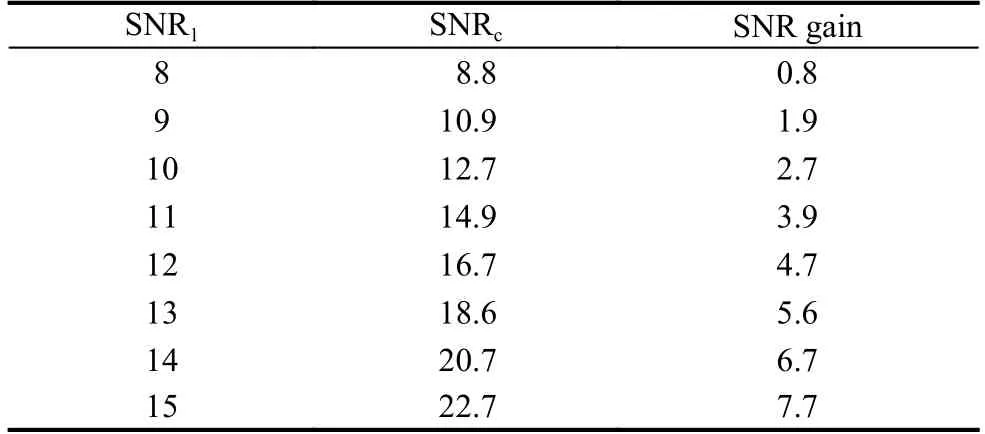

4.3 Experiment II: validation of the detector performance

4.4 Experiment III: analysis of measured data







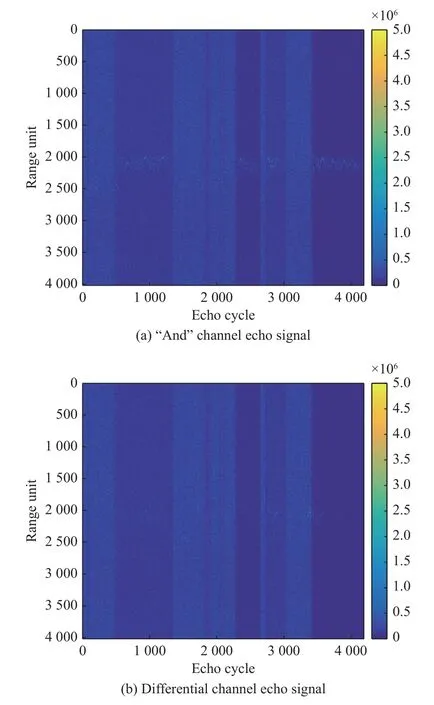






5.Conclusions
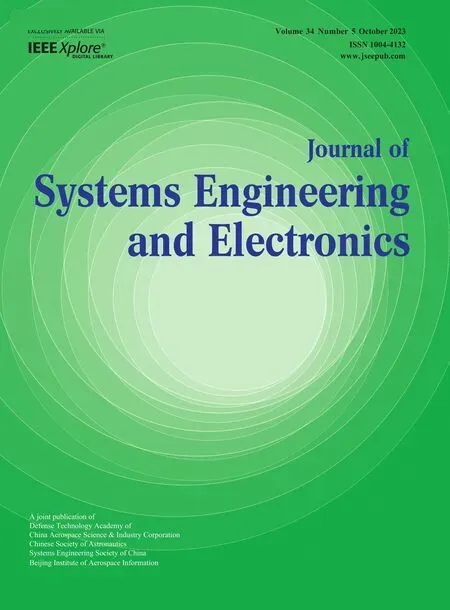 Journal of Systems Engineering and Electronics2023年5期
Journal of Systems Engineering and Electronics2023年5期
- Journal of Systems Engineering and Electronics的其它文章
- A spawning particle filter for defocused moving target detection in GNSS-based passive radar
- Cuckoo search algorithm-based optimal deployment method of heterogeneous multistatic radar for barrier coverage
- Radar fast long-time coherent integration via TR-SKT and robust sparse FRFT
- Deep convolutional neural network for meteorology target detection in airborne weather radar images
- Super-resolution parameter estimation of monopulse radar by wide-narrowband joint processing
- Non-LOS target localization via millimeter-wave automotive radar
